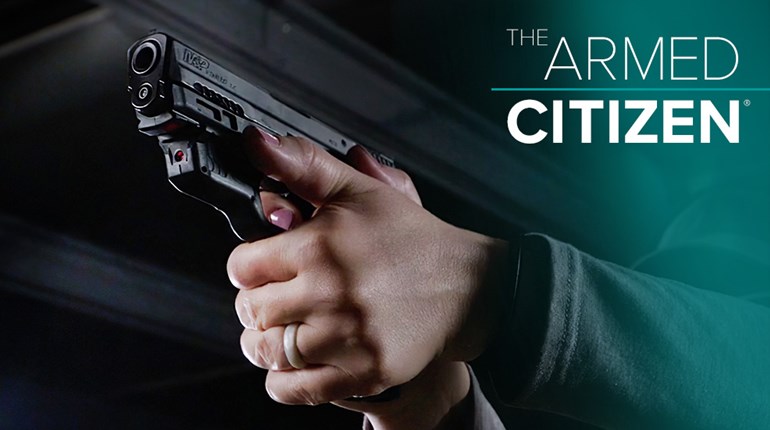
We’ve been considering the flashlight as a defensive tool, noting that flashlights have one important similarity to your carry firearm—they’re a “stand-off” technology. Put more directly, this means that they can be used at a distance, with all the advantages that implies, and not just to make an aggressor more visible.
In this role, they have some advantages. As far as we know, they remain legal pretty much everywhere, even on an airplane, to say nothing of a campus or hospital parking ramp. They also don’t inflict permanent damage when used in their stand-off mode, and so incur no legal jeopardy. And used well—and by this we mean decisively in both senses of that word (quickly and effectively)—they can buy literally life-saving seconds for other action(s). Just maybe, using your carry firearm can be avoided altogether. But like any other defensive technique, this one rests 100 percent on your mindset and state of awareness.
“Seconds,” however, and “maybe” are the utterly crucial operative words.
“Seconds,” because this is how long the blinding effect of a flashlight will last, and “maybe” because the time and distance bought are finite: Certainly, for instance, you won’t have time to call 911. (Remember, even with an unlocked, in-the-hand phone, the quickest you can expect to connect with a 911 operator is about eight seconds, and actually getting help to you will take much, much longer—four to five minutes would be about half the national average.)
As a Tueller drill clearly demonstrates, this “connect” span is also at least twice as long as you have to take defensive action. Effectively disappearing from your aggressor for even a fraction of this interval nevertheless provides time for many other expedients: putting an object (like a car) or barrier (a door, preferably lockable) between yourself and the problem. A brisk walk will take you 10-12 yards in this time frame. As always, distance and obstacles are your friends, as the Tueller drill so starkly demonstrates.
But like any other defensive technique, this one rests 100 percent on your mindset and state of awareness. First, it implies that your flashlight is immediately available, perhaps even more so than your firearm. If you’re even slightly condition “orange,” your light should be in your hand. There’s just no reason not to.
Next, that immediate reaction/action must run on two parallel tracks. “Take no pity” is the first: Put every lumen at your command directly in the eyes of that aggressor. Your goal is closed eyes (usually an unavoidable reflex) and a turned head. Even a positively ancient Surefire 3P (only 15 lumens) will get the first reaction from across the room to night-adapted vision and is disruptively bright through closed eyelids at six feet or so—though you’d prefer never to allow closure to that extent. A modern version will easily be four-to-six times the power, half the diameter (~.5”) and have 10 times the endurance: The head-turn and the further spatial disorientation it brings then become very likely. At 200 lumens and above, it’s all but guaranteed, and will even work in daylight: They’re that bright. Expect to practice with your light to employ it effectively: Where the switch is and how it works (on the barrel or end-cap are the usual options) are just the beginning.
The second track is to take your “countermeasure” as soon as the eye close/head turn occurs. You’ve compromised an aggressor’s plan (gotten inside his OODA loop), so get away from the last navigational “fix” he or she had on you. One serious caution applies here: Do not, repeat do not, back up. You’re likely to trip/stumble in short order, and expose yourself to a potentially devastating back-of-the-head injury even before the assailant recovers his vision. Get your toes in the direction you want to move and get going. Away from the aggressor is less important than movement that doesn’t compromise other actions, up to and including a defensive fight. Diagonal retreat is best for reasons a little beyond our immediate scope, but toward cover/concealment, light, authority and other people are the main drivers of this decision. Keep in mind, you’ve also been screaming bloody murder this whole time, so you hope to have attracted attention (this should stop only when and if your considerable racket would re-alert an attacker to your position).
Everybody knows how to use a flashlight, right? Not, as the old expression goes, on your tintype, buster, or at least in this way. Like your firearm, there are absolutely gobs of possibilities and choices, none of which will meet every need. What constitutes “normal” attire, and to a lesser extent, gender-linked factors along those lines may drive selection to a surprising extent. Women’s clothing, for instance, frequently lacks the sturdier, roomier pockets afforded men. A major “duh,” then, that this is a consideration in choosing that 5-6 ounce, 5-inch, 750 lumen pocket supernova (Streamlight ProTac HL) vs. a merely blistering 70 lumen, sub-2 ounce gem that you can secret just about anywhere (Streamlight Stylus Pro; USB rechargeable). It’s only slightly larger than a decent pen. You’ll also find many lights with a “strobe” mode (rapidly flashing) designed specifically for disorienting.
A trick, ladies, if you still routinely carry a traditional purse: A “lanyard” (a serpentine-style chain is best) pinned at the upper corner of the opening of your purse can bring your light into pre-use position very conveniently with virtually no pawing around or other concessions to how you “run” your bolsa. This works for a satchel or briefcase too, gents.
Expect to practice with your light to employ it effectively: Where the switch is and how it works (on the barrel or end-cap are the usual options) are just the beginning. Putting that disruptive power to protective use still requires an “aiming” act under duress—not with the same down-range consequences for a firearms miss or blunder to be sure, but still with very limited time to get the job done.
Shining as a defensive technique may turn into a head game at this point. It’s very likely to make that person mad, as it has all the trappings of being “had.” If the window for the attack is/was small, he may still come to his limited, criminal senses and break off. If not, well, we’re at the nub, and precisely why a flashlight cannot replace a firearm. Using them together has challenges all its own, so next week then?
Now Carry on.


































